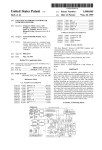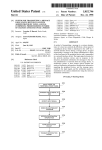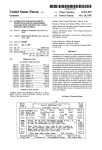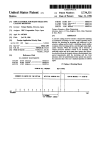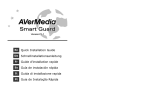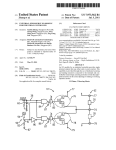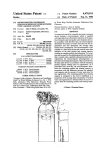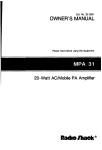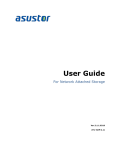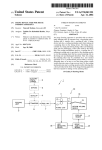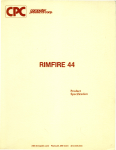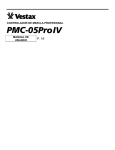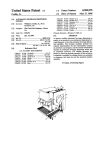Download Two-line telephone controller
Transcript
llllllllllllllIlllllllllllllllllllllllllllllllllllllllllllllllllllllllllll US 0055 1 5423A Unlted States Patent [191 [11] Patent Number: Beck et a1. [45] [54] Date of Patent: TWO-LDZE TELEPHONE CONTROLLER Puane Maxcm?’ “DIIAA DeIsigners Guides, Sep" 1989' Douglas L Palmer, Foothill Ranch; James A_ Fontana, Mission vieI-o; 4LS User Manual , Vers1on 1.0, B1com Computer and Communications Systems, pp. 1-5. “RC96ACL/RC144ACL Modem Designer’s Guide”, Rock Alistair Egan Lake Forest. Richard D_ Ray Laguna lingual. Lisa walker well International Digital Communications Division, pub Capistrano Beach, all of Calif. hshed 1993' _ _ _ _ Primary Examiner—Jason Chan [73] Asslgne?: Canon Kabushlkl Kalsha’ Tokyo’ Japan Attorney, Agent, or Firm—Fitzpatrick, Cella, Harper & Scinto [21] Appl. No.: 160,824 [57] [22] A computer-controlled Dec_ 3 1993 ’ [51] [52] [58] May 7, 1996 OTHER PUBLICATIONS [75] Inventors: Gregory F. Beck, Laguna Hills; Filed: 5,515,423 ABSTRACT communication board which includes a data access arrangement which functions as an Int. Cl.6 ................... .. H04M 11100 US. Cl. ........... .. 379/93; 379/94; 379/100 Field of Search ................................ .. 379/93, 94, 95, intermediary between multiple telephone lines, a data com munication device such as a fax/modem/voice chipset, and a standard telephone handset. The data access arrangement 379/96, 97, 98, 99, 160, 163, 156; 395/325; 375/222 References Cited has aline select switch which switchably connects one of the multiple telephone lines to the data communication device via a single transformer and associated 2/4 converter. Off hook switches are provided for each telephone line so that U'S‘ PATENT DOCUMENTS phone line to go off-hook. Likewise, n'ng detectors are [56] the data communication device can cause the selected tele 3,771,134 11/1973 Huettner et a1. ...................... .. 395/325 3,920,928 11/1975 Lye ................ .. . 3791163 Provided for each t91912110119 line 80 that the data communi‘ cation device can detect which of those lines is ringing. 4,578,537 4,640,939 3/1986 Faggin etal. 2/1987 Rimf'r 61111 Telephone handset switches may be provided for each telephone line so that the telephone handset may be swit 4,825,461 379/93 379/94 4/1989 Kunta et a1. ............................ .. 379/93 chably connected to any one of the multiple telephone lines_ 151,322,493 1319311) (Sjhung ...... "2.1.1......................... .. 29/91/32 The data access mangemem may be con?gured so that ’ 5 A3 5,131,026 7 379/98 379,100 unused lines appear “busy” to incoming calls, or it may be . . . . con?gured m a voice local mode in wh1ch the telephone . . . .. 379/100 hands/9t may be used for Play out and r?cording of audio 9 .oleman et ' lida ............... .. 7/1992 Park 5,056,133 10/1991 5,142,567 2/1992 5,151,972 9/1992 Lorenz m1. .... .. Watanabe . . . . . . . . 5,224,155 6/1993 5,283,819 2/1994 Glick et a1. ............................. .. 379/93 379/93 Satomi et al. .... .. 3 . VOICE I LOCAL ' - - -, 1 ' 1 —> col?ggngn 21%.] RING \54 51M 1 FBITO I I 55 J s2 _ MODEM DATAPUMP ' i 1 I LOGIC I i LINE SELECT 4 I #1/#2 I _ 64 , /- f" 1 F 2/4 CONVERTER SDI I_ : I I L42 I I I . MODEM/ VOICE 44 * VOICE ‘ ‘7 ' ' ' ‘ ‘ ‘ ‘ ‘ 7 ' ‘ 13 II \- 71 4 _./ “ a_ 20 +\/ f 71/ I 57 I SPEAKER ‘ I19 63 61 l ‘I 1 51 I[ RING T'P HANDSET I 52£__AUDIO our 100 I “T PHONE L 5 I CHIPSET I SENSE I HANDSETTOLINE1 ‘I_ FAX] 1 I HANDSETTO LlNE2 : : L CURRENT 3 1 I LOOP 1 t-Bnr I I 5 1 74 | CONTROL : I MODEM OFFHOOK LINE 1 l MODEM OFFHOOK LINE2 I A \50 I 1W‘ M2324 I l 1 :DEYECT I 49 Claims, 5 Drawing Sheets ,""iaap'auaagN‘Tsé;Ea (1&5, ------------- "1 I ------- - - I information . 379/100 ‘(f _ UNEI Rlgjr 78 65 ) RING DETZZT BITO 67 l mNG DETECT1 L: ] I I LINE2 l I RING I DETECT_2 I VOICE" LOCALMODE +\/ Em I “21 US. Patent May 7, 1996 5,515,423 Sheet 1 0f 5 16 12 E30‘ 1 22 2O NTEWORK L#1INE 21 TELPOHNE TELPOHNE #2LINE 15 US. Patent May 7, 1996 .rOmjwz Sheet 5 of 5 X N O w I Z H E j O humjw.I z mtm mtm 5,515,423 5,515,423 1 2 TWO-LINE TELEPHONE CONTROLLER munication device, are provided for each telephone line so that the data communication device can cause the selected telephone line to go off-hook. Likewise, ring detectors are provided for each telephone line so that the data communi cation device can detect which one of those lines is ringing. Telephone handset switches may be provided for each telephone line so that a telephone handset may be switchably BACKGROUND 1. Field of the Invention The present invention concerns a telephonic communica tion apparatus in which a data modem or the like is select connected to a selected one of the telephone lines. The handset switches are preferably controlled such that the telephone handset is not connected to the telephone line ably switchable, under computer control, to any one of multiple telephone lines. More particularly, the invention concerns a two-by-two switching matrix that functions as an currently engaged in data communication. intermediary between two standard telephone lines, a fax/ modem/voice chipset and a standard telephone handset. 2. Description of the Related Art There are many communication control board products adapted for use with computing equipment such as an IBM In operation, a ringing signal on one of the multiple telephone lines is detected, and a determination is made as to which line is ringing. The line select switch and the telephone handset switch are switched to the ringing line. If the user does not lift the handset within a predetermined PC and PC-compatible computers. These boards perform integrated modem/facsimile/ telephone control functions. period, such as two rings, the data communication device is caused to go off-hook. When connected to an ordinary voice telephone line and to an ordinary telephone handset, such communication boards allow a computer to send and receive facsimile transmis sions via a fax modem, to send and receive data transmis sions via a data modern, and to send and receive voice telephone communications either via a digitized voice ?le stored on the computer or via the analog telephone handset. A single line controller is described in U.S. application Ser. 20 A local voice mode is also provided whereby the com munication board can be used for local play out and record ing of audio infonnation. This brief summary has been provided so that the nature of the invention may be understood quickly. A more com 25 plete understanding of the invention can be obtained by reference to the following detailed description of the pre No. 08/005,554, ?led Jan. 19, 1993, commonly assigned ferred embodiment thereof in connection with the attached herewith, the contents of which are incorporated herein by reference. Computer users today ordinarily have more than one telephone line available to them. They use these multiple telephone lines to permit the computer to transmit fax/ drawings. 30 BRIEF DESCRIPTION OF THE DRAWINGS FIG. 1 is a perspective view of the outward appearance of modem/voice messages over one telephone line at the same time as an ordinary voice conversation is conducted on a an apparatus illustrative of a communication arrangement for personal computing equipment in which the present telephone handset over a second telephone line. But because 35 invention is incorporated. conventional communication boards, which support only one telephone line, require connection to the telephone handset, this ?exibility is lost. This is particularly the case in situations where a user desires the computer to control operations of the ordinary telephone handset, such as by automatic dialing from the computer or automatically main 40 taining telephone usage statistics. FIG. 2 is a block diagram of the FIG. 1 apparatus. FIG. 3 is a functional block diagram of a communication board according to the invention. FIG. 4 is a schematic circuit diagram of the communica tion board shown in FIG. 3. FIG. 5 is a schematic circuit diagram of the control logic shown in FIG. 4. SUMMARY OF THE INVENTION It is an object of the invention to address the foregoing 45 difficulties through the provision of a two-line telephone controller. DETAILED DESCRIPTION OF THE PREFERRED EMBODIMENT FIG. 1 is a view showing the outward appearance of a In one aspect, the invention provides a data access arrangement for a computer-controllable communication representative embodiment of the invention. Shown in FIG. 1 is computing equipment 10 such as an IBM PC or board in which the data access arrangement functions as an PC-compatible computer having an operating system such intermediary between two standard telephone lines, a fax/ modern/voice chipset and a standard telephone handset. Under computer control, the data access arrangement swit chably connects any of multiple telephone lines to an ordinary telephone handset or to a fax/modem/voice chipset. 55 as a Microsoft Windows operating system. The computing equipment 10 is provided with a display screen 11 such as a color monitor, a speaker 12 and a microphone 13. Com puting equipment 10 further includes a mass storage device such as a computer disk drive 14 for storing data ?les such With this arrangement, a computer user can utilize the as bitmap image data ?les, text data ?les, sound (e.g., PCM computer to control both fax/modem/voice communications as well as to control an ordinary telephone handset, and at or pulse code modulation) data ?les, animation data ?les and digital motion video data ?les, in compressed or uncom the same time allow simultaneous use of those devices. pressed format; and for storing application program ?les More particularly, a communication board according to such as a multimedia message management program that the invention includes a data access arrangement having a can send and receive the aforementioned types of data ?les, or other information processing program ?les which contain line select switch which switchably connects one of multiple stored program instruction steps by which computing equip telephone lines to a data communication device, such as connecting one of multiple telephone lines to a fax/modem/ voice chipset, via a single transformer and associated 2/4 converter. Off—hook switches, controllable by the data com 65 ment 10 manipulates data ?les, presents data in those ?les to an operator via display screen 11 or speaker 12, or transmits data via telephone lines or network interfaces, or the like. 5,515,423 3 4 Keyboard 15 is connected to computing equipment 10 to permit input of text data and to permit operator selection and manipulation of objects displayed on display screen 11. provide computing equipment 10 with access to and control over multiple telephone lines and an ordinary telephone handset. The communication board device on 40 preferably Likewise, pointing device 16 such as a mouse or the like is includes a combined fax/modem/voice chipset such as the connected to permit selection and manipulation of objects on type described in the RC96ACL/RC144ACL Modem the display screen. Scanner 18 scans documents or other Designer’s Guide, Rockwell International Digital Commu nications Division, published 1993, the contents of which images and provides bitmap images of those documents to computing equipment 10. Network interface line 22 con nects computing equipment 10 to an unshown local area network, and printer 24 is provided for outputting informa tion processed by computing equipment 10. 10 An unshown communication board, which is described in voice communication capability for digitizing incoming considerable detail below, connects computing equipment 10 to an ordinary telephone handset 19 as well as to a multiple telephone lines, here two telephone lines 20 and 21. In accordance with operator instructions, stored applica tion programs are activated and permit processing and manipulation of data. For example, any of a variety of 15 editing program, spreadsheet programs, and similar infor mation processing programs, may be provided for operator selection and use. Thus, a word processing program may be activated to permit an operator to create, view, manipulate and print documents, and to send or receive documents via a communication board and one of the multiple telephone lines. Likewise, a multimedia message management pro gram may be activated to permit an operator to create, 20 switch for selecting any one of multiple telephone lines for connection to the fax/modem/voice chipset. The DAA fur ther includes the capability for connecting to external speaker 12 or microphone 13 as well as for connecting to ordinary voice telephone handset 19. 25 FIG. 3 is a functional block diagram of communication board 40. As shown in FIG. 3, communication board 40 includes a communication device such as the aforemen tioned fax/modem/voice chipset 41, and a 2/4 converter 42. manipulate and view multimedia documents which contain a variety of objects such as text objects, bitmap objects, computer graphic objects, sound objects and motion video voice communications and storing the digitized voice in a computer ?le, and/or converting a digitized voice in com puter ?les into analog form for play out over voice telephone lines. The communication board 40 further includes a data access arrangement (DAA) which includes a line select application programs such as a multimedia message marr agement program, a word processing program, an image are incorporated herein by reference. Such a fax/modem! voice chipset provides a facsimile modem for automatic facsimile transmission and reception, a data modem for automatic data transmission and reception and a digital The 2/4 converter 42 converts a four-Wire signal from the 30 objects, and to send and to receive such multimedia docu ments via the communication board on one of the multiple fax/modem/voice chipset 41 into a two-wire signal for connection to ordinary voice telephone lines. The two-wire signal from 2/4 converter 42 is fed to data access arrange ment (DAA) 44. The data access arrangement, under control telephone lines. The multimedia message management pro gram may also be provided with telephone handset control capabilities with which an operator, through manipulation via control logic 45 from chipset 41 and computing equip ment 10, switchably connects one of multiple telephone lines, such as telephone lines 20 and 21, to the chipset via the 2/4 converter 42. Additionally, DAA 44 includes handset and use of a computerized address list, may instruct the computer to cause a selected telephone line to go off-hook, a selected telephone number to be dialed, and indicate to the 40 switches for each telephone line for switchably connecting, under control via control logic 45 from chipset 41 and computing equipment 10, one of the telephone lines to telephone handset 19. Preferably, and as depicted in FIG. 3, the communication board 40 is arranged on a single, multiple-layer, circuit 45 computer (RISC) interfaced to computer bus 31. Also inter board provided with an edge connector 43 for connection to computer bus 31, as well as suitable RJ-l4 connectors for connection to handset 19 and telephone lines 20 and 21. The single-board construction allows board 40 to be inserted into faced to computer bus 31 is scanner interface 32 for inter the housing of conventional PC-type computing equipment. facing to scanner 18, display interface 34 for interfacing to display 11, network interface 35 for interfacing to network line 22, printer interface 36 for interfacing to printer 24, keyboard interface 37 for interfacing to keyboard 15, and pointing interface 38 for interfacing to pointing device 16. Read only memory (ROM) 101 interfaces with computer bus 31 so as to provide CPU 30 with specialized and Of course, while a single-board construction is preferred, the communication board 40 may, in fact, be comprised by multiple interconnected circuit boards. FIG. 4 is a schematic diagram illustrating the communi cation board of FIG. 3. As shown in FIG. 4, the fax/modem! operator that the called party has answered. Incoming calls may also be handled by the computer, and a telephone usage log may be maintained. FIG. 2 is a detailed block diagram showing the internal construction of computing equipment 10. As shown in FIG. 2, computing equipment 10 includes central processing unit (CPU) 30 such as an 80386 or a reduced instruction set invariant functions such as start-up programs or BIOS programs. Main memory 110 which includes random access memory (RAM) provides CPU 30 with memory storage both for data and application programs, as required. In particular, when executing stored program instruction sequences such as multimedia message management pro grams, CPU 30 nonnally loads those instruction sequences from disk 14 (or other program storage media) to main 50 voice chipset 41 includes a modern controller 50 connected 55 via modem bus 51 to a modem data pump 52. Also con nected to modern bus 51 are EPROM 54 and local RAM 55 which serve as memories for programming and processing operations of the modem and which may have a capacity of 128K bytes each. An audio path in chipset 41 includes an audio output interface portion 52a of the modem data pump which is connectable to speaker 12, as well as an audio-in switch 56 which permits connection to microphone 13 so as to provide the modem data pump 52 with an audio input memory 110 and executes those stored program instruction interface under control of AND device 57. sequences out of the main memory. 65 In operation, modem controller 50, via commands and A communication board 40 which includes a data com~ data sent from computing equipment 10 on computer bus 31, munication device is connected to computer bus 31 so as to sets its state and the state of the modem data pump to one of 5,515,423 5 6 audio in, audio out, fax modem, data modem or voice. Then, output audio signals to speaker 12, to input audio signals desired lines 20 or 21 via line select switch 61. The appro priate one of off-hook switches 63 or 64 is then closed and the modem controller 50 causes modern data pump 52 to from microphone 13, or to transmit or receive fax, modem initiate telephone dialing such as DTMF or pulse dialing or voice information via a four-wire connection to 2/4 converter 42. 2/4 converter 42 converts the four-wire connection from modern data pump 52 into a two-wire connection to data over the selected line. Handset switches 70 and 71 are set in accordance with the selected line, and the user is then instructed to lift the handset from telephone handset 19. As soon as loop current detect (LCD) signal is detected, indi access arrangement (DAA) 44. As further shown in FIG. 4, DAA 44 includes a trans cating the presence of loop current between the tip and ring wires of telephone handset 19, modem controller 50 discon~ modem controller 50 causes modem data pump either to nects both of off-hook switches 63 and 64 to permit the user to conduct ordinary voice communication. If the user does former 60 for impedance-matching the two-wire signal from 2/4 converter 42 to the impedance of an ordinary voice telephone line. A line select switch 61 is provided to select one of multiple telephone lines, here two lines designated 20 and 21, respectively. The line selector switch 61 is operated not lift the handset from telephone handset 19, then the LCD signal will not be detected, and when the called party answers, the fax/modem/voice chipset 41 will operate in 15 under control from modern control logic 45 so as to select either of the two lines. Each of the telephone lines has connected in series therewith a modern off-hook switch, speci?cally modern off-hook switch 63 for line 20 and 64 for line 21. Under control from control logic 45, each of those switches may be that one of the telephone lines carries a ringing signal, and signals that detection to modern controller 50 via AND gate 20 activated so as to cause the selected line to go oiT-hook with respect to fax/modem/voice chipset 41 when line select switch 61 has selected that line. Ring detect circuits 65 and 66 detect ringing signals on each of lines 20 and 21, respectively. In response to a ringing 25 signal, each ring detect circuit sets a bit in an unshown prograrnmed instructions. Ordinarily, computing equipment 10 is programmed such that if the LCD signal is detected by the user lifting the handset from telephone handset 19, off-hook switches 63 and 64 are both disconnected leaving the user in ordinary voice communication with the calling 35 40 off-hook and engaged in modem operations. 45 100. The handset switches 70 and 71 are operated under control of control logic 45 via “handset to line 1” and “handset to line 2” control signals. These signals are set such that only one telephone line is connected to telephone handset 19 at any one time, and preferably they are set such telephone line, the handset is not connected to that line. A loop current detect device 74 is positioned between the ring and tip wires of telephone handset 19 so as to sense a loop current when the handset in telephone handset 19 is lifted. If a loop current is detected, then loop current detect device 74 sends a loop current detect (LCD) signal to modern controller 50 and to AND gate 57. Telephone handset 19 is operable in either a manual mode 60 or a computer-controlled mode. In the manual mode, when telephone handset 19 is lifted, it is connected to one of 19 thus alerting the user aurally to the presence of such a ringing signal. phone 13 or from the microphone in telephone handset 19. More speci?cally, when the voice local mode is desired, a voice local mode signal is sent from modern controller 50 to voice relay 75 thereby disconnecting DAA 44 from all telephone lines and reconnecting it to V*. Thereafter, sound from modern data pump 52 may be heard over speaker 12 or the speaker in telephone handset 19. At the same time, sound may be recorded from either microphone 13 or from the microphone in telephone handset 19. In this regard, using loop current detect signal LCD, AND gate 57 will block telephone lines 20 or 21 in accordance with the setting of handset switches 70 and 71. Manual outgoing dialing and For computer-controlled outgoing dialing, computing Because the ring detect signal is blocked, chipset 41 will not DAA 44 further includes a voice relay 75 for setting DAA 44 to a voice local mode. In the voice local mode, voice relay 75 is activated to disconnect DAA 44 from all telephone lines and to connect the DAA to a V‘“ voltage supply. In the voice local mode, the communication board can be used to play out sound over either speaker 12 or the speaker in telephone handset 19, or to record sound either from micro that if data conununications are being conducted on one equipment 10 ?rst causes modem controller 50 to select the As mentioned above, if the fax/modem/voice chipset 41 is engaged in data communications via one of telephone lines 20 or 21, then the ring detect signal to chipset 41 is blocked via AND gate 68 because of the existence of the OH signal. ordinarily set to the unused telephone line, any incoming calls on that line will activate the ringer in telephone handset The DAA further includes for each telephone line a voice communication may then occur. part)’ be interrupted in its fax or modem or voice communications. At the same time, because handset switches 70 and 71 are rupted from its modern operations when one of the lines is ‘handset switch 70 and 71 for connecting lines 20 and 21, respectively, to telephone handset 19 via handset interface 45 then switches line select switch 61 to the appropriate line. In addition, control logic 45 sets handset select switches 70 or 71 to the ringing line. If, after a predetermined period such as two rings, the LCD signal is not detected indicating that the user has not lifted the handset, then control logic 45 causes the ringing line to go off-hook by setting modem voice chipset then operates in accordance with its pre ringing. In addition, the ring detect signals are ORed thereby preventing modern controller 50 from being inter 68. Computing equipment 10 reads its unshown computer register to determine which line is ringing, and control logic off-hook switches 63 or 64, as appropriate. The fax/modem/ computer register indicating which of the lines 20 and 21 is together via OR gate 67 and the resultant ORed signal sent to AND gate 68. The resultant ring detect signal is sent to modern controller 50 whereby modem controller 50 can recognize when one of line 20 and 21 is ringing. In this regard, AND gate 68 is provided so that a ring detect signal is blocked when modem controller 50 is engaged in modem operations. Thus, when either of lines 20 or 21 is off-hook via off-hook switches 63 and 64, an oi‘rr hook signal OH is generated by modern controller 50. The OH signal blocks a ring detect signal in the event that either line is oiT-hook, accordance with its ordinary programming. For incoming calls, ring detect circuits 65 and 66 detect 65 recordal of sound from microphone 13 in the case that the handset has been lifted from the telephone handset 19 thereby preventing sound from being recorded from both the telephone handset and microphone 13 at the same time. 5,515,423 7 8 Relay 76 operates to force a busy signal on unselected ones of the multiple telephone lines. Thus, as shown in FIG. 4, relay 76 is connected to each of the telephone lines between the line select switch 61 and off-hook switches 63 and 64. The relay 76 is actuated through inverter 77 by the‘ line select signal from control logic 45, and operates to connect the unused telephone line to resistor R1. Force busy is obtained by closing the off-hook switch for the unselected HANDSET TO LINE l=BIT3 HANDSET TO LINE2=BIT3 More simply, as shown in Table I above, bit 3 controls handset switches 70 and 71, and bit 4 controls line select switch 61. As for off-hook switches 63 and 64, off-hook switch 63 (corresponding to line #1) is closed if modem controller 50 signals to go off-hook by raising oiT-hook signal OH and if line #1 is selected (i.e., bit 4:0), and also telephone lines, thereby connecting the telephone line to resistor R1 which has a value, e.g., 100 Q, low enough to indicate to the telephone central o?ice that the unused 10 telephone line is busy. As an operational example, if line signals to go oIT-hook by raising off-hook signal OH and if select switch 61 is set to select line #1, then because of inverter 77 force busy relay 76 connects resistor R1 to line #2. To force busy on line #2, control logic 45 causes modem off-hook switch 64, corresponding to line #2, to close. The telephone central of?ce “sees” resistor R1 and interprets that resistor as an indication that line #2 is busy. Thus, callers calling into line #2 will receive a busy signal even though no line #2 is selected (i.e., bit 4:1), and also if line #1 is selected (i.e., bit 4:0) and bit 2 is set to force busy on unselected lines. In operation, and in response to an incoming call on any of the phone lines, the system preferentially activates the data communication device, here the modem/fax/voice physical telephone equipment (e. g., telephone handset 19 or chipset, while activating the handset when the communica tion device is busy. In addition, the communication device is protected from unwanted interruptions while allowing a user chipset 41) is connected to line #2. As mentioned above, control of the communication board is accomplished through bit settings in an unshown com puter register. The following tables I and 11 show those bit settings: if line #2 is selected (i.e., bit 4:1) and bit 2 is set to force busy on unselected lines. Likewise, off-hook switch 64 (corresponding to line #2) is closed if modem controller 50 manually to respond to incoming phones via the telephone 25 handset 19. It is also possible to block incoming calls by forcing unused lines to a busy state. Such functionality is preferred in an unattended state where a user is unable to TABLE I respond manually to incoming telephone calls while the I/O WRITE T0 CONFIGURATION REGISTER (BASE +0) communication device is in use. The reason why such ?mctionality is desirable is because a caller calling an unattended station may become aggravated at an unan 7 6 5 4 3 2 I 0 30 i—— - com port setting - 0: don’t force busy on unselected lines I: force busy on unselected lines 35 - 0: handset to line #1 In general, after detecting a ring detect signal, computing l: handset to line #2 - 0: line select to line #1 40 1: line select to line #2 - IRQ setting 45 TABLE II swered telephone line and will be less aggravated if a busy signal is instead obtained. In addition, automatic message dialing systems, such as remote facsimile machines, ordi narily have re-try modes for message dialing, and those re~try modes are activated only if a busy signal is obtained. Of course, it is possible to replace telephone handset 19 with an ordinary voice telephone answering machine to accom modate unattended operation. equipment 10 performs an I/O read of its ’BASE+2” register to determine which line is ringing. As shown in the above Table II, if bit 0 is set, then line 1 is ringing while if bit 1 is set then line 2 is ringing. After determining which line is ringing, the handset is moved to the ringing line by setting the appropriate one of handset switches 70 and 71. Then, by performing an I/O write to hit 4 of the “BASE+O” register, as shown in the above Table I,~line select switch 61 is set to I/O READ CONFIGURATION REGISTER +2 (BASE +2) 50 I- - line 1 ringing the ringing line, and by performing an I/O write to the BASE+O register, the appropriate one of modem o?-hook switches 63 and 64 is set to the ringing line. The call is then answered via chipset 41 or by the user lifting the handset of telephone handset 19, which action is detected by modern controller 50 through the loop current detect (LCD) signal, - line 2 ringing as described hereinabove. Speci?c operations taking into consideration the current FIG. 5 is a detailed schematic diagram of control logic 45. As shown in FIG. 5, control logic 45 accepts the off-hook signal OH from modern controller 50 and combines it, using OR and AND gate logic circuitry, with control bits 2, 3 and 4 from “BASE +0” register so as to obtain the line select signal for line select switch 61, the modem off-hook signals for off-hook switches 63 and 64, and the handset signals for handset switches 70 and 71. The logic circuitry implements state of the telephone handset and the fax/modem/voice chipset are described as follows: (Incoming Call On Line 1) 60 the following boolean equations: LINE SELECT: BIT4 OFFHOOK LINE 1=(OH-§TZ)+(BIT2-BIT4) OFFHOOK LINE 2=(OH'BIT4)+(BIT2'BIT4) 65 If neither the fax/modern/voice chipset 41 nor telephone handset 19 is in use, then computing equipment 10 connects both chipset 41 and telephone handset 19 to line 1 as described hereinabove. If chipset 41 is not in use but line 2 is in use by telephone handset 19, then computing equipment 10 connects chipset 41 to line 1. 5,515,423 10 If chipset 41 is currently conducting communications on a data access arrangement having a line select switch line 2, and telephone handset 19 is not in use, then com puting equipment 10 moves telephone handset 19 to line 1 interposed between the two-wire connection of said 2/4 converter and said multiple telephone lines, said data access arrangement operable under computer control to switchably select the two-wire signal from any one of for attended voice operation. Alternatively, by setting bit 2 of “BASE O”, which causes unselected lines to appear said multiple telephone lines so as to electrically con nect the selected two-wire signal from any of said multiple telephone lines to said two-wire connection of “busy” to the telephone central of?ce, it is possible to force busy on line 1 for unattended operation. If both the modem and the phone handset are conducting communication on line 2, then line 1 is forced busy by setting bit 2, as described above. said 2/4 converter. 2. A communication board according to claim 1, wherein said data access arrangement includes a transformer inter posed between said line ‘select switch and said two-wire connection of said 2/4 converter, said transformer providing (Incoming Call On Line 2) If neither chipset 41 and telephone handset 19 are in use, impedance matching between the selected two-wire signal computing equipment 10 connects both chipset 41 and telephone handset 19 to line 2. If chipset 41 is conducting communication on line 1, and telephone handset 19 is not in use, then computing equip from any of said multiple telephone lines and the two-wire 15 ment 10 connects telephone handset to line 2 for attended operation. Alternatively, it is possible to force busy on line 2 by setting bit to of “BASE+0” register for unattended 20 operation. connection of said 2/4 converter. 3. A communication board according to claim 1, wherein said communication device is comprised by a fax/modem/ voice chipset. 4. A communication board according to claim 1, further comprising force busy means which operates in dependence on which of said multiple telephone lines is selected by said line select switch so as to force a telephone busy condition If chipset 41 is not in use but telephone handset 19 is in on unselected ones of said multiple telephone lines. use with line 1, then computing equipment 10 connects 5. A communication board operable under computer con 25 chipset 41 to line 2. trol, said communication board comprising: If both chipset 41 and telephone handset 19 are conduct a data access arrangement for accessing multiple tele ing communication on line 1, then line 2 is forced busy by phone lines each of which includes a tip and ring wire, setting bit 2 of “BASE+O” register. said data access arrangement including a line select switch which switchably connects the tip and ring wires (Outgoing Calls From Chipset 41) For an outgoing call by chipset 41, then computing equipment 10 preferentially connects chipset 41 to the ?rst available line, i.e., ?rst line 1 or if line 1 is in use then to line 2. Alternatively, it is possible for computing equipment 10 to override this automatic selection by appropriate writes to bits in the “BASE+0” register. 35 multiple telephone lines. 6. A communication board according to claim 5, wherein said data communication device is comprised by a fax/ (Outgoing Calls From Handset 19) modem/voice chipset. For outgoing calls on telephone handset 19, then if neither telephone line is in use, computing equipment 10 connects telephone handset 19 in reverse preferential order to that of 7. A communication board according to claim 5, further comprising an off-hook switch for each of said multiple telephone lines, each oiT-hook switch being positioned in series with its respective phone line and being operable chipset 41. Thus, computing equipment 10 ?rst connects telephone handset 19 to line 2, or if line 2 is in use by chipset 41 then to line 1. In the event of an outgoing call from the telephone handset while line 1 or line 2 is in use by chipset 41 it is possible for computing equipment 10 to allow the user to 45 line select switch is caused to switch to one of said multiple telephone lines that is ringing and said o?”—hook switch for said one of said multiple telephone lines that is ringing is into their appropriate state and allows the user to break into the line by lifting the handset. In summary, for the above situation, the “preferential switched to an off-hook position. 55 2. Accordingly, the “reverse preferential order” for selecting one of the telephone lines for connection to the telephone handset is line 2 followed by line 1. What is claimed is: 1. A communication board operable under computer con 60 trol so as to select a two-wire signal from any one of multiple telephone lines, said communication board comprising: 9. A communication board according to claim 8, further comprising means for blocking ring detect signal in the case where the data communication device is engaged in data communication. 10. A communication board according to claim 7, further comprising force busy means connected between said off hook switches and said line select switch, said force busy means operating in dependence on which of said multiple telephone lines is selected by said line select switch so as to force a telephone busy condition on unselected ones of said multiple telephone lines. a 2/4 converter having a two-wire connection and a four-wire connection, said four-wire connection being under computer control to cause a telephone line, which is selected by said line select switch, to go off-hook. 8. A communication board according to claim 7, further comprising a ring detect means for each of said multiple telephone lines, wherein in response to ring detection, said “break into” the phone call by chipset 41. In this instance, computing equipment 10 forces handset switches 70 and 71 order” for selecting one of the telephone lines for connection to the data communication device is line 1 followed by line of a selectable one of said multiple telephone lines to a two-wire output of said data access arrangement; and a 2/4 converter for converting the two-wire output from said data access arrangement to four-wire communica tion so as to permit interface between a four-wire data communication device and the selectable one of the connectable to a four-wire signal from a data commu 11. A communication board according to claim 10, wherein said force busy means is comprised by a relay, and nication device; and wherein the telephone busy condition is forced on unse 65 5,515,423 11 12 lected ones of said multiple telephone lines whose off-hook switches are actuated. that is ringing and said off-hook switch for said one of said multiple telephone lines that is ringing is switched to an 12. A communication board according to claim 5, further comprising one handset switch for each of said multiple oiT-hook position. 23. Apparatus according to claim 22, further comprising telephone lines, each said handset switch for switching its respective telephone line to a telephone handset interface. 13. A communication board according to claim 12, further comprising a loop current detector for detecting loop current means for blocking ring detect signal in the case where the communication device is engaged in data communication. at said telephone handset interface. 14. A communication board according to claim 13, wherein said data communication device includes an audio 24. Apparatus according to claim 21, further comprising force busy means connected between said off-hook switches and said line select switch, said force busy means operating 10 input interface, said audio input interface being selectively in dependence on which of said multiple telephone lines is selected by said line select switch so as to force a telephone busy condition on unselected ones of said multiple telephone lines. 25. Apparatus according to claim 24, wherein said force busy means is comprised by a relay, and wherein the telephone busy condition is forced on unselected ones of said multiple telephone lines whose oiT-hook switches are actuated. blocked in accordance with loop current detection. 15. A communication board according to claim 13, wherein said telephone handset interface is connected to one 15 of said multiple telephone lines in response to loop current detection. 16. A communication board according to claim 5, further comprising a transformer interposed between said 2/4 con 26. Apparatus according to claim 19, further comprising verter and said line select switch, said transformer for 20 one handset switch for each of said multiple telephone lines, matching impedance from said 2/4 converter to that of said each said handset switch for switching its respective tele multiple telephone lines. phone line to a telephone handset interface. 17. A communication board according to claim 5, further 27. Apparatus according to claim 26, further comprising comprising a voice relay for disconnecting all of said a loop current detector for detecting loop current to said multiple telephone lines from said data access arrangement. 25 telephone handset interface. 18. A communication board according to claim 5, further 28. Apparatus according to claim 27, wherein said data comprising a ?rst microphone connectable to the data com communication device includes an audio input interface, munication device, a telephone handset which includes a said audio input interface being selectively blocked in second microphone and which is also connectable to the data accordance with loop current detection. communication device, and a loop current detector for 29. Apparatus according to claim 27 , wherein said tele detecting loop current at said telephone handset, wherein phone handset interface is connected to one of said multiple only one of the ?rst and second microphones are operable in telephone lines in response to loop current detection. accordance with loop current detection. 30. Apparatus according to claim 19, further comprising 19. A telephone communication apparatus comprising: a transfonner interposed between said 2/4 converter and said computing equipment programmed to send and to receive 35 telephone communication over any one of multiple telephone lines using a data communication device; and line select switch, said transformer for matching impedance from said 2/4 converter to that of said multiple telephone lines. 31. Apparatus according to claim 19, further comprising a communication board connected to said computing a voice relay for disconnecting all of said multiple telephone equipment and responsive to program control from said lines from said data access arrangement. computing equipment so as to select any one of said 32. Apparatus according to claim 19, further comprising multiple telephone lines, said communication board a ?rst microphone connectable to the data communication device, a telephone handset which includes a second micro phone and which is also connectable to the data communi being comprised by a 2/4 converter having a two~wire connection and a four-wire connection, said four-wire connection connected to a four-wire signal from the data communication device, and a data access arrange 45 cation device, and a loop current detector for detecting loop current at said telephone handset, wherein only one of the ment having a line select switch interposed between the first and second microphones are operable in accordance two-wire connection of said 2/4 converter and said multiple telephone lines, said line select switch oper able under computer control to switchably select a two-wire signal from any one of said multiple tele phone lines so as to electrically connect the selected two-wire signal from any one of said multiple tele phone lines to said two-wire connection of said 2/4 50 telephone handset and at least one data communication device, said control method comprising the steps of: a data-communication-line-selecting step of selecting one of said multiple telephone lines as a ?rst-selected signal converter. 20. Apparatus according to claim 19, wherein said data communication device is comprised by a fax/modem/voice with loop current detection. 33. A control method for controlling telephonic commu nications between multiple telephone lines and at least one 55 for connection to said data communication device in a ?rst preferential order which determines which of said chipset. 21. Apparatus according to claim 19, further comprising multiple telephone lines said ?rst-selected signal is selected from; and one off-hook switch for each of said multiple telephone lines, each o?f-hook switch being positioned in series with its a handset-line-selecting step of selecting another one of said multiple telephone lines as an second-selected respective phone line and being operable under computer signal for connection to said telephone handset, control to cause a telephone line, which is selected by said line select switch, to go off-hook. wherein said handset-line-selecting step selects one of 22. Apparatus according to claim 21, further comprising a ring detect means for each of said multiple telephone lines, wherein in response to ring detection, said line select switch is caused to switch to one of said multiple telephone lines 65 said multiple telephone lines in a second preferential order which determines which of said multiple tele phone lines said second'selected signal is selected from, said second preferential order being in reversed order from said ?rst preferential order. 5,515,423 13 14 34. A method according to claim 33, further comprising a moving a line select switch for said at least one data step of conducting data communication by said communi communication device to said ringing telephone line; transmitting a two-wire signal from said ringing telephone cation device over the selected one of said multiple tele phone lines. line from said line select switch to a two-wire connec tion of a 2/4 converter; and transmitting a four-wire signal from a four-wire connec 35. A method according to claim 34, wherein said step of conducting data communication is preceded by a step of closing an off-hook switch. 36. A method according to claim 34, further comprising a step of connecting said telephone handset to an unused one of said multiple telephone lines in accordance with said second preferential order. 37. A method according to claim 34, further comprising a tion of said 2/4 converter to said at least one data 10 step of forcing busy on unused ones of said multiple communication device. 42. A method according to claim 41, wherein the detecting step includes a step of writing a bit indicative of said ringing telephone line to a computer register. 43. A method according to claim 42, wherein the deter mining step includes a step of reading bits in said computer register. telephone lines. 44. A method according to claim 41, further comprising a 38. A method according to claim 37, further comprising a 15 step of detecting loop current in the telephone handset in the step of connecting a low resistance resistor across tip and case that said telephone handset goes oiT-hook. ring wires of unused ones of said multiple telephone lines. 45. A method according to claim 44, further comprising a 39. A method according to claim 33, wherein said data step of going off-hook for said at least one data communi communication-line-selecting step includes a step of switch cation device in the case that loop current is not detected ing a line select switch so as to connect a two-wire data within a predetennined period. 46. A method according to claim 45, further comprising a step of going on-hook for said at least one data communi access arrangement to a four-wire data communication device via a 2/4 converter. 40. A method according to claim 33, wherein said hand set-line-selecting step includes the step of selectively switching a respective one of plural handset select switches. 41. A control method for controlling telephonic commu nications between multiple telephone lines and at least one telephone handset and at least one data communication device, said control method comprising the steps of: detecting a ring signal on one of said multiple telephone lines; detemiining which of said multiple telephone lines is a ringing telephone line; connecting a handset switch to said ringing telephone line; 25 30 cation device in the case that loop current is detected after going off-hook for said at least one data communication device, 47. A method according to claim 41, further comprising a step of going off-hook for the data communication device. 48. A method according to claim 47, further comprising a step of blocking ring detect signals in a case where said data communication device is off-hook. 49. A method according to claim 47, further comprising a step of moving the handset switch to an unselected line in a case where the data communication device is off-hook.













